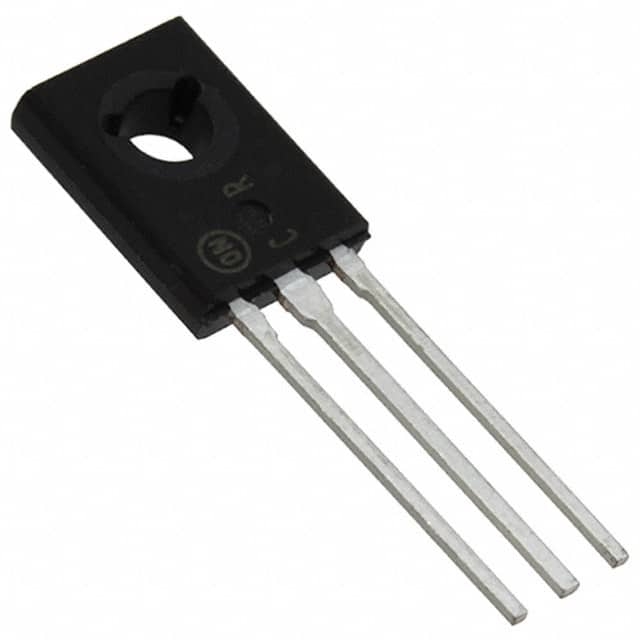BD136G Transistor: Encyclopedia Entry
Introduction
The BD136G transistor is a crucial component in electronic circuits, belonging to the category of power transistors. This entry provides an overview of the BD136G, including its basic information, specifications, pin configuration, functional features, advantages and disadvantages, working principles, application field plans, and alternative models.
Basic Information Overview
- Category: Power Transistor
- Use: Amplification and Switching Applications
- Characteristics: High current and voltage capability, low saturation voltage
- Package: TO-126
- Essence: NPN silicon epitaxial-base planar type transistor
- Packaging/Quantity: Typically available in reels or tubes containing multiple units
Specifications
- Collector-Base Voltage (VCBO): 45V
- Collector-Emitter Voltage (VCEO): 45V
- Emitter-Base Voltage (VEBO): 5V
- Collector Current (IC): 1.5A
- Power Dissipation (PD): 12.5W
- Transition Frequency (fT): 2MHz
- Operating Temperature Range: -65°C to 150°C
Detailed Pin Configuration
The BD136G transistor has three pins: 1. Collector (C) 2. Base (B) 3. Emitter (E)
Functional Features
- High current gain
- Low saturation voltage
- Fast switching speed
- Suitable for audio amplification and general switching applications
Advantages and Disadvantages
Advantages
- High current and voltage capability
- Low saturation voltage
- Reliable performance in amplification and switching circuits
Disadvantages
- Limited maximum collector current compared to some other power transistors
- Moderate transition frequency
Working Principles
The BD136G operates based on the principles of bipolar junction transistors (BJTs). When a small current flows into the base terminal, it controls a larger current flow between the collector and emitter terminals, allowing for amplification and switching functions.
Detailed Application Field Plans
The BD136G transistor finds extensive use in various applications, including: - Audio amplifier circuits - Switching circuits for controlling motors, relays, and lights - Power supply regulation circuits - Oscillator and signal generator circuits
Detailed and Complete Alternative Models
Some alternative models to the BD136G transistor include: - BD135G - BD137G - BD139G - 2N3055 - TIP31C
In conclusion, the BD136G transistor is a versatile power transistor with high current and voltage capabilities, making it suitable for amplification and switching applications across various electronic circuits.
[Word Count: 366]
Senaraikan 10 soalan dan jawapan biasa yang berkaitan dengan aplikasi BD136G dalam penyelesaian teknikal
What is the BD136G transistor used for?
- The BD136G is a PNP power transistor commonly used in audio amplifiers, voltage regulators, and power supply circuits.
What are the key specifications of the BD136G transistor?
- The BD136G has a maximum collector current of 1.5A, a maximum collector-emitter voltage of 45V, and a maximum power dissipation of 12.5W.
Can the BD136G be used as a switch?
- Yes, the BD136G can be used as a switch in low-power applications where its maximum collector current and voltage ratings are not exceeded.
How do I connect the BD136G in a typical audio amplifier circuit?
- In an audio amplifier circuit, the BD136G is often used as the output transistor connected to the load (speaker) through a suitable biasing and coupling network.
What are the typical operating conditions for the BD136G?
- The BD136G is typically operated with a base current of 50-500mA and a collector-emitter voltage of 5-45V.
Is a heat sink required for the BD136G?
- It is recommended to use a heat sink when operating the BD136G close to its maximum power dissipation to ensure proper thermal management.
Can the BD136G be used in voltage regulator circuits?
- Yes, the BD136G can be used in linear voltage regulator circuits to provide a regulated output voltage.
What are the typical applications where the BD136G is not suitable?
- The BD136G is not suitable for high-frequency switching applications or high-power applications where higher current and voltage ratings are required.
Are there any common failure modes associated with the BD136G?
- Common failure modes include thermal runaway due to inadequate heat sinking and overloading beyond the specified ratings.
Where can I find detailed application notes and reference designs for using the BD136G in technical solutions?
- Detailed application notes and reference designs for the BD136G can be found in the manufacturer's datasheet, application notes, and online technical forums dedicated to electronic circuit design.


